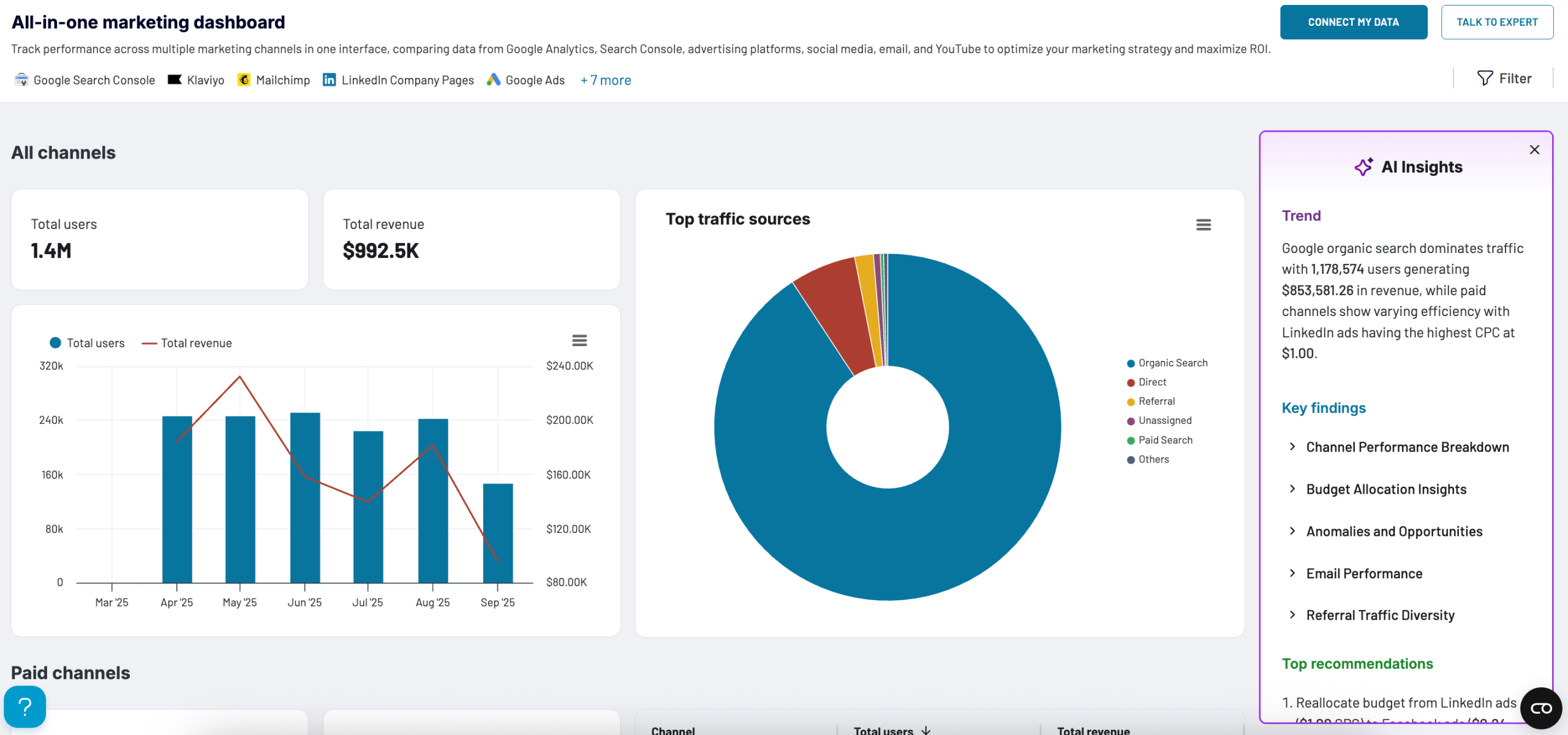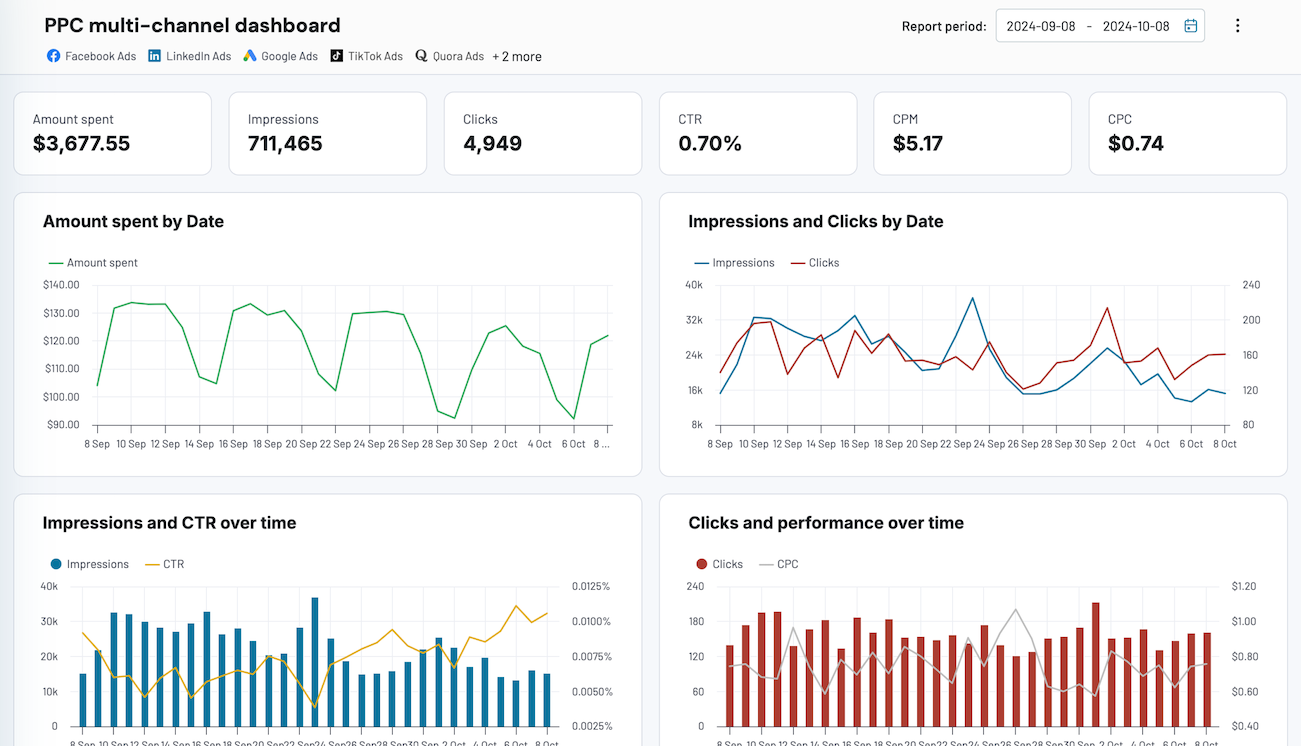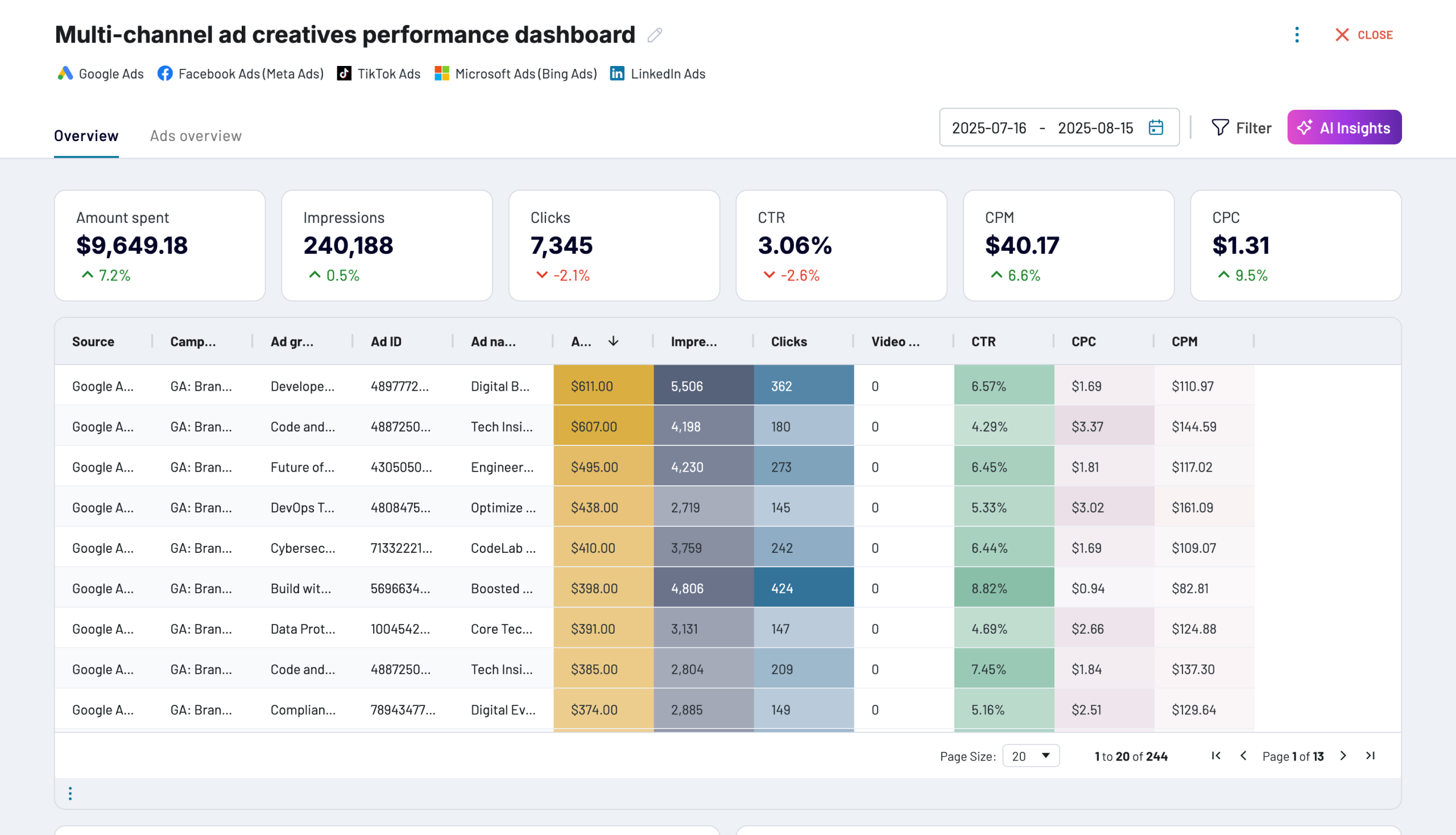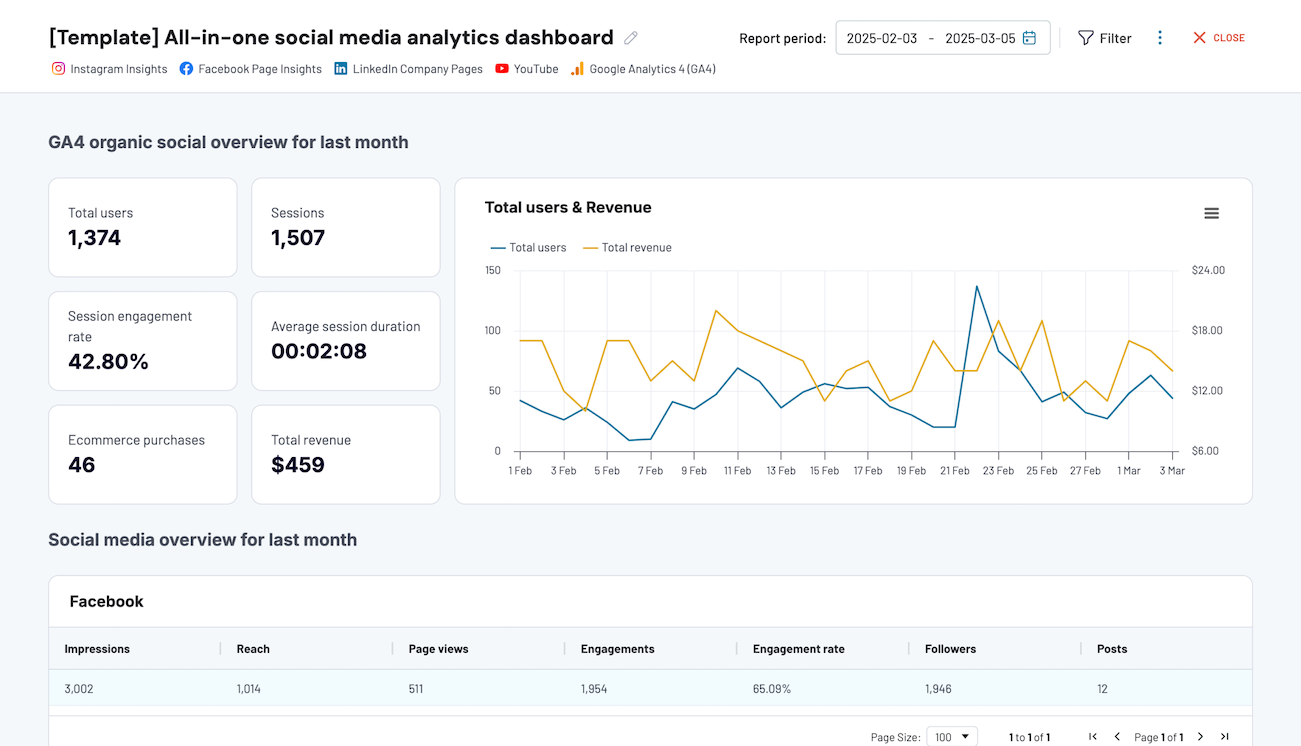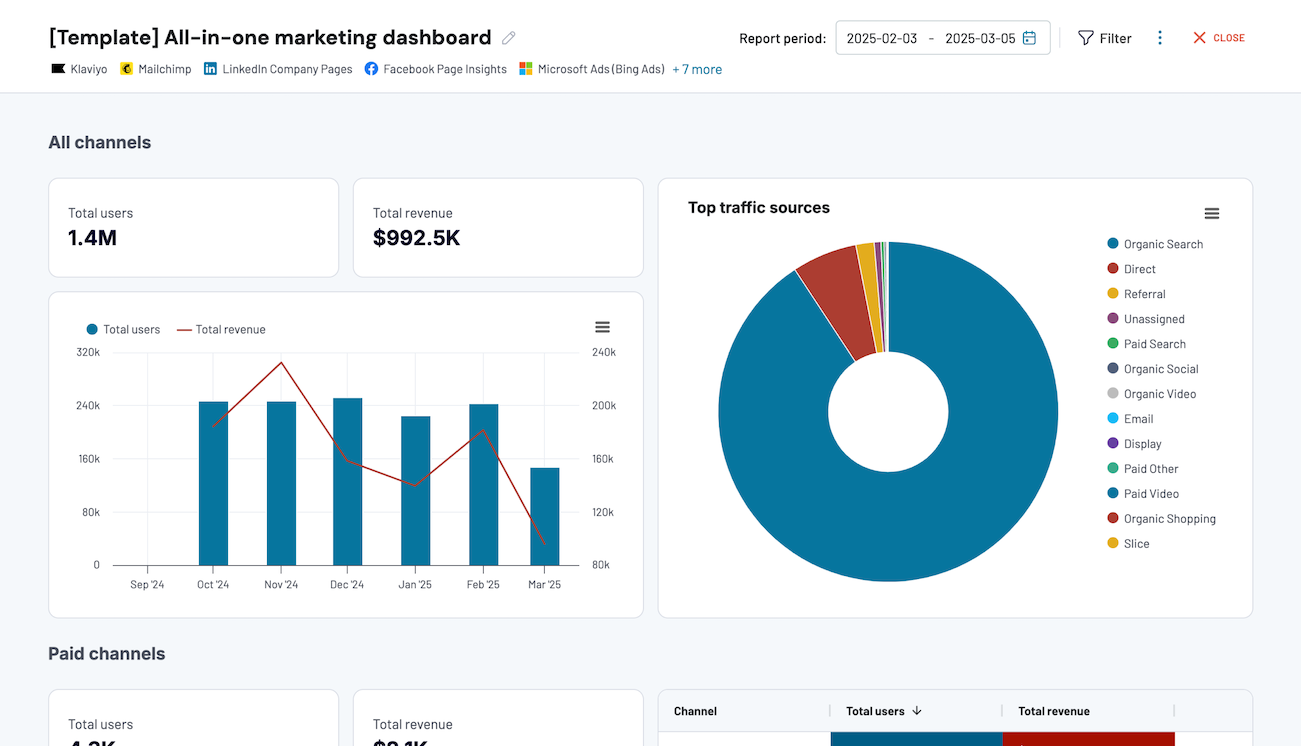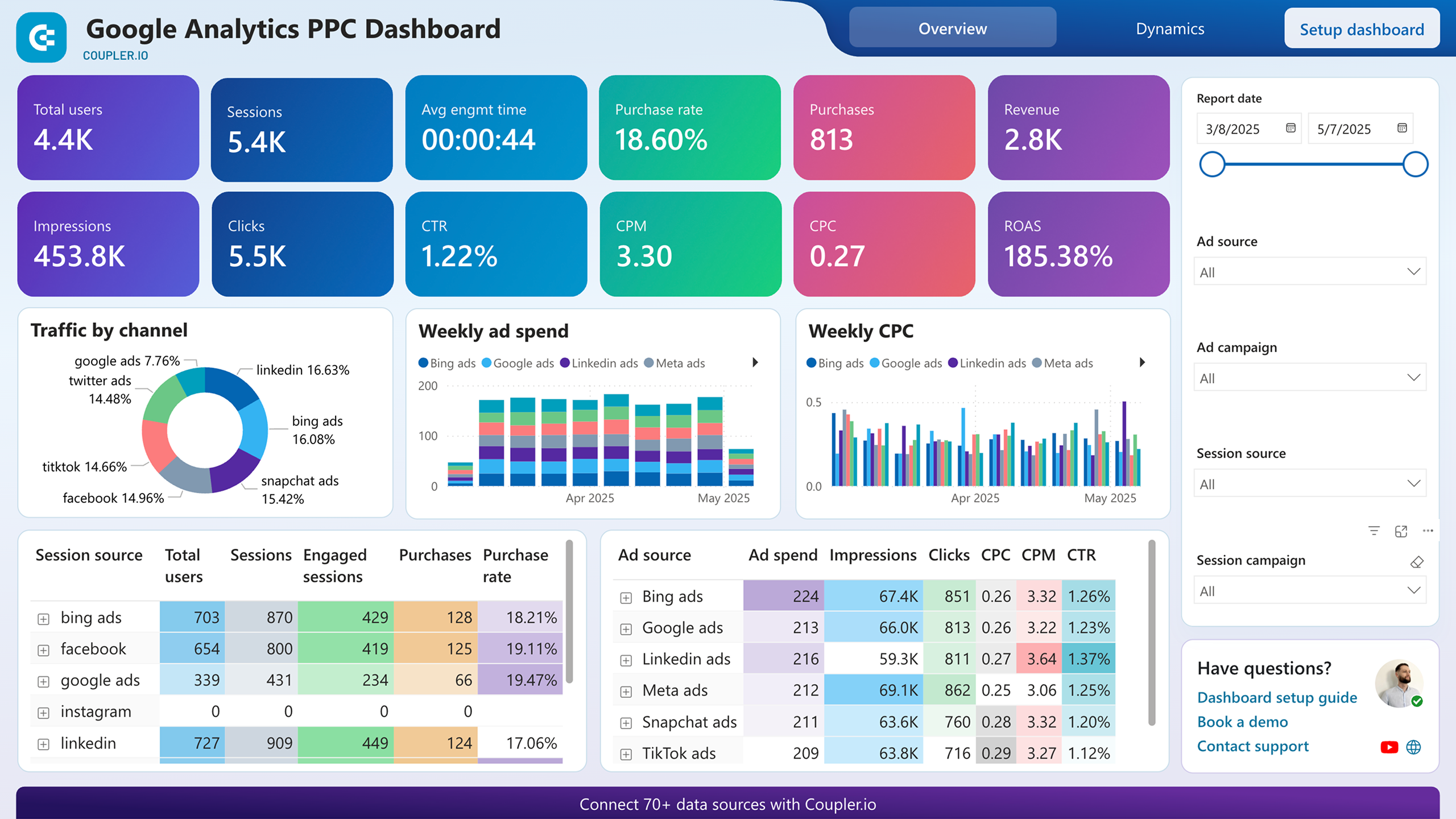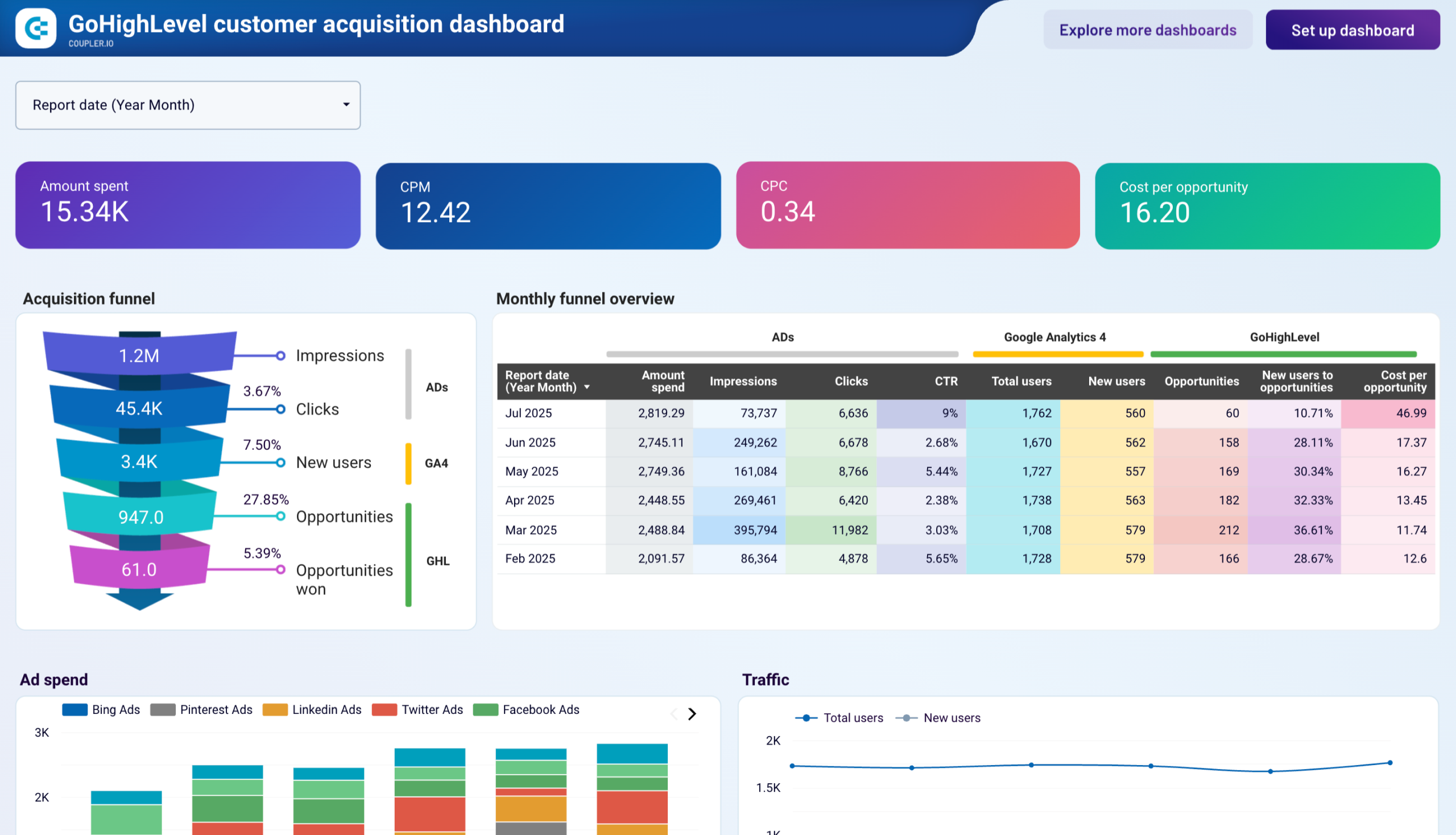Marketing is changing faster than it has in decades. New research from McKinsey shows that 42% of companies now regularly use AI in their marketing operations, with 16% applying it directly to marketing strategy.
For many teams, the change is less about tools and more about how daily decisions are shaped and supported. They can create personalized content en masse, adjust campaigns in real-time, and get tailored insights at the click of a button. What took hours or days to achieve a few years ago, now only takes a few minutes.
That’s quite a leap from where things stood in 2023. In our research on data-driven marketing that year, teams told us they were:
- struggling with traffic attribution
- overwhelmed by disconnected, meaningless data
- finding it hard to keep up with market trends
- constrained by tight budgets and limited time
While these challenges haven’t gone away, artificial intelligence is changing how teams tackle them.
To understand this shift, we recently surveyed 149 professionals – including marketing leaders, managers, CMOs, founders, and business executives from agencies, SaaS companies, and e-commerce. We asked them how they’re using AI for marketing strategy, what’s working, and how it’s changed their decision-making processes.
The new reality: AI-driven marketing strategy in modern business
In marketing, AI is primarily used to scale content production and automate repetitive tasks. But more and more professionals are starting to see its value for strategic decision-making.
Beyond marketing automation: AI as strategic partner
Our 2025 research revealed that most teams aren’t asking AI for help with big-picture tasks, like go-to-market planning or customer profiling. Yet many are using it for day-to-day tasks that directly impact strategic direction – trend analysis, campaign results forecasting, budgeting predictions, etc.
In fact, 25% of respondents identified analytics as their top area for AI implementation. Access to personalized insights is making it easier for teams to adjust marketing strategy on the fly. For Jason Marshall, the Chief Growth Officer at Huntress Labs, the benefit is clear:
As AI is able to draw from thousands of sources concurrently, you can begin to strategize based on precise marketing data. This is especially useful when running segmented marketing campaigns or in A/B testing scenarios, where the higher volume of data gives you a clearer picture of what is or isn’t working.
Apart from analytics, teams are leveraging AI across three other strategic areas:
- Content marketing (24%) – content creation for different channels (blog, email, etc.) as well as content planning, scheduling, and refining.
- SEO (23%) – keyword research, topic clustering, content gap analysis, analyzing user intent, and optimizing website content. Learn more about AI impact on SEO.
- Paid ads (14%) – audience targeting, creative performance analysis, and bid optimization are among the many other things of AI impact on PPC.
Interestingly, smaller numbers of professionals are using AI to optimize the customer experience, such as for customer analytics (7% of respondents) and personalization (5%). This includes tasks like building buyer journeys and lifecycle maps, funnel analysis, segmentation, A/B testing, and crafting product recommendations.
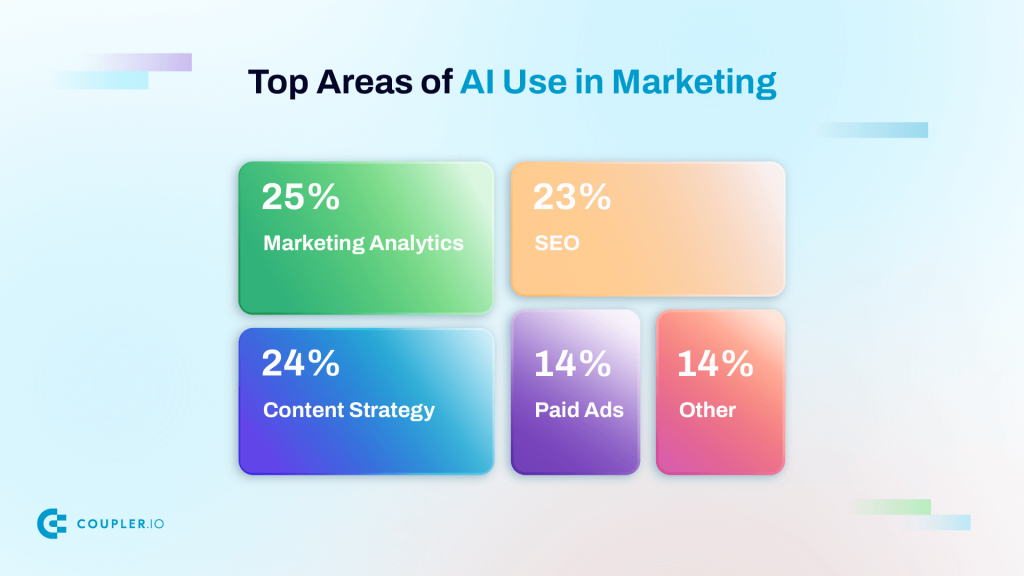
Key marketing pain points that AI helps solve
As our 2023 research showed, marketers have long struggled with attribution blind spots, fragmented data, and a marketing environment evolving faster than they can keep up. Let’s look at how AI is helping address these challenges, according to responses from our 2025 survey:
- Attribution clarity: 15% of respondents say AI helps them better identify which channels, campaigns, and touchpoints drive conversions.
- Campaign optimization: AI can analyze huge volumes of historical data in real-time, giving teams clear direction on where to adjust budgets, creatives, or targeting while campaigns are still live. 39% of marketers told us they are already using AI for this purpose.
- Predictive foresight: To keep up with everchanging conditions, 35% of marketers now rely on predictive analytics and AI-driven forecasting. As Cal Singh, Head of Marketing & Partnerships at Equipment Finance, explains:
I can look right at the first week of a campaign and see that a particular set of ad creatives are generating leads at an above-average close rate, at which point I would scale up the budget of those assets by 30-40 percent on the spot. It removes the guesswork of scaling – I don’t have to sit and wait until the end of a reporting cycle to take action.
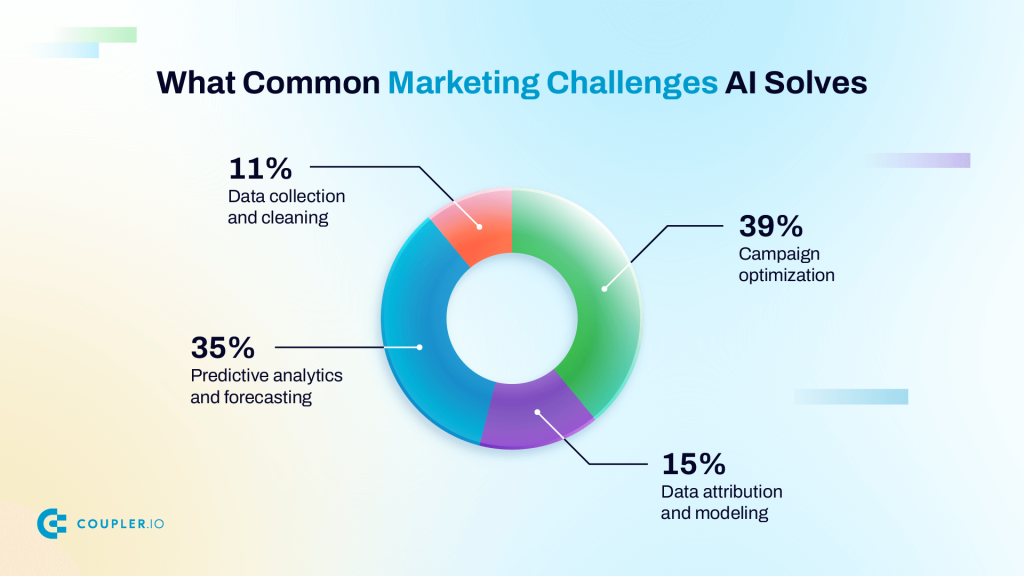
AI in marketing decision-making: Transforming analytics
Analytics is where the impact of AI is most visible. Instead of waiting days – or until the end of a quarter – for answers, teams can now explore data in real-time and get quick, actionable insights to guide marketing direction. Here are four strategic areas where AI is changing how data-driven decisions are made:
Conversational analytics
For years, getting answers from marketing data meant either waiting for reports or navigating complex dashboards. Conversational analytics – powered by AI – simplifies the whole process by letting you ‘talk’ to your data. You can ask questions in plain English and get instant, contextual answers.
In our survey, 28% of respondents said they use AI to identify trends and patterns in their data sets. This tracks with the exploding popularity of generative AI tools for analytics. For example, Coupler.io provides integrations with AI tools like ChatGPT, Claude, and Perplexity. You can collect marketing data from multiple sources (300+), connect it to your preferred AI tool, and start asking questions directly, like: ‘What’s the ROI for each of my marketing channels this month?’
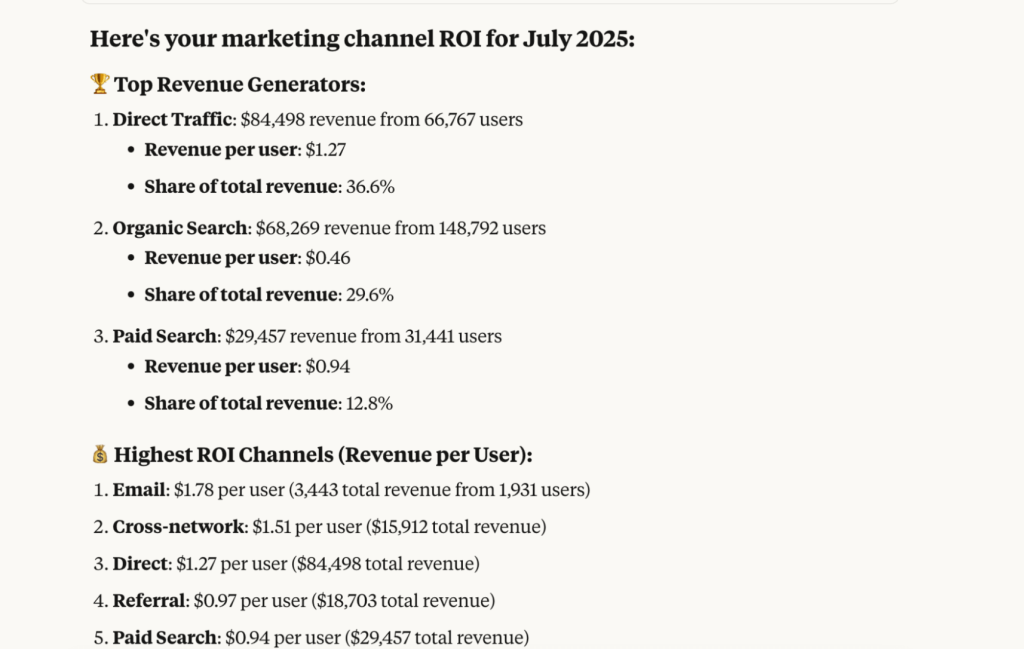
The result is a faster path from analysis to action. Coupler.io’s dedicated integrations makes analyzing data in AI tools more efficient, helping you avoid lengthy decision cycles. Try any one of them with a free Coupler.io account.
AI-powered dashboards
Marketers have relied on dashboards for years to keep track of performance, but those reports often stopped at ‘what happened.’ AI-powered dashboards go a step further. They can help you understand why a drop occurred and what to do about it.
AI Insights by Coupler.io was designed for that purpose. It’s an optional feature in Coupler.io marketing dashboards that highlights trends, anomalies, and opportunities in your data. It also provides a list of recommendations based on what it finds – for example, reallocating spend toward a high-performing channel, optimizing email campaigns to improve deliverability, or expanding your YouTube content strategy to capture more organic traffic.
You can try some of these dashboards yourself with a free Coupler.io account:
Ultimately, the benefit of AI-powered dashboards is speed and clarity in decision-making. Instead of spending hours analyzing charts and graphs, teams can get tailored advice with a button click. It’s no wonder that in our 2025 survey, 24% of professionals said they already use AI for visualization and reporting tasks – a sign that dashboards are quickly becoming more than just reporting tools.
Attribution intelligence
Figuring out which marketing efforts lead to sales has always been tricky. While AI can’t solve all of your attribution problems, it can help connect more dots across your customer journeys and reveal patterns that traditional last-click models miss.
For example, AI-driven attribution might show that customers who convert through email campaigns typically visited your blog multiple times and clicked on retargeting ads before making a purchase. This is made possible by machine learning algorithms in tools like GA4, Adobe Analytics, HubSpot, and Salesforce.
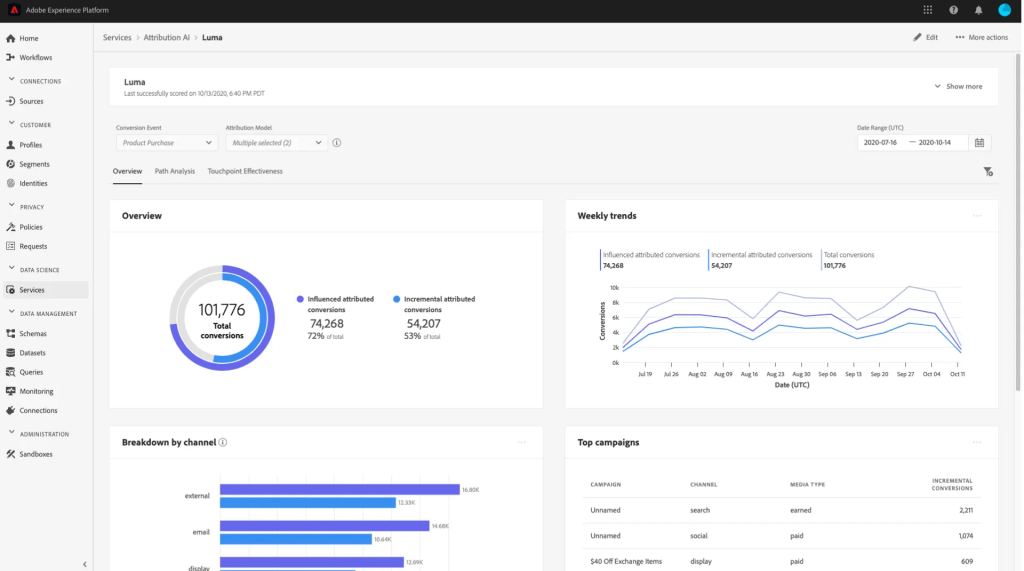
Clearer insights into the customer journey feed directly into decision-making. When you see how your channels work together, it’s easier to refine campaigns and focus on touchpoints that actually drive results.
Predictive insights
Predicting customer behavior has always been a mix of data and guesswork. AI doesn’t remove uncertainty, but it makes forecasting faster and more reliable than before. In fact, our survey found that 18% of teams are using AI for customer segmentation and personalization, where predictive insights often play a key role. As Jason Hennessey, CEO of Hennessey Digital, explains:
We have seen the biggest AI impact in lead qualification and ad personalisation. AI scoring models help us rank leads by how likely they are to convert, allowing our sales team to focus on the most promising ones. In advertising, AI adjusts messaging in real time to match audience behaviour, which raises click-through rates without increasing costs.
Of course, predictions work best when combined with business context and market knowledge. An AI system might suggest increasing ad spend on Google Search by 30%, but you’ll still need to factor in budget constraints, campaign goals, and current priorities. The main difference is that decision-making is no longer highly reactive. Predictive insights allow your team to act faster and with more confidence.
How to use AI for marketing strategy: Tool selection and implementation framework
Popular AI tools for marketing strategy in 2025
These days, marketing teams use a variety of specialized tools for different tasks rather than relying on a single platform. When we asked survey participants about their tool usage, the breakdown looked like this:
📝 Content generation
ChatGPT (including OpenAI API and add-ons) was the most popular tool overall, used by 21% of respondents to generate and refine marketing content. 16% turn to platforms like Jasper and Canva for creating social media posts, visuals, and brand-aligned copy.
🔎 SEO and optimization
20% of respondents rely on tools like SurferSEO, Clearscope, and Ahrefs for content optimization and keyword strategy.
🎯 Analytics and reporting
Most experts stick with AI functionality built into the tools they already know and love, such as Tableau, Google Analytics 4, and Looker Studio Pro.
💡 Market and competitor research
A small proportion of respondents (3%) use Claude for complex research tasks, competitor analysis, ad campaign optimization recommendations, etc. Well, Claude integrations with your business data can really be helpful for conversational analytics.
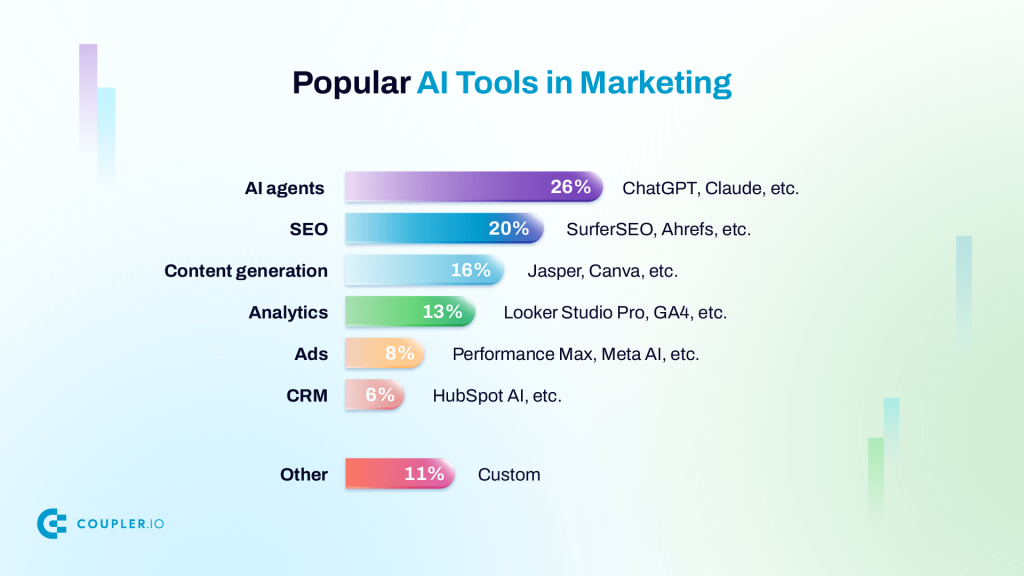
Here’s what stands out: marketing professionals aren’t putting all their eggs in one basket. They’re using a mix of AI tools across channels, which shows that AI’s influence on marketing strategy only continues to grow.
Choosing the right AI tools for marketing strategy development
With so many AI tools and features hitting the market, the selection process can feel overwhelming. Is a basic LLM like ChatGPT enough, or should you be experimenting with specialized tools for analytics and strategic planning? There’s no right or wrong answer here – but sporadic prompting in Claude will only get you so far.
Here are the key criteria to consider when evaluating AI marketing tools for strategic use:
- Integration with existing workflows. Choose tools that can seamlessly integrate with your current systems (CRM, analytics platforms, collaboration tools). For instance, Coupler.io can automatically pull data from 300+ business apps for AI analysis and insights generation. It supports Claude and ChatGPT integrations for efficient conversational analysis of data.
- Strategic vs. tactical focus. Will the tool help you make better strategic decisions or just execute tasks faster? Look for providers that offer built-in insights and conversational analytics besides standard automation (e.g., smart scheduling, AI-generated copy).
- Scalability and pricing. Consider how costs will scale with your data needs. Some platforms charge per user, others by data volume or level of AI usage (such as tokens). The right choice depends on how your team expects to grow in size and data complexity.
- Support and reliability. Many AI tools and features are brand new or in beta mode, which can mean unexpected bugs or gaps in functionality. Providers that offer reliable support (e.g. 24/7 response), clear set-up instructions, and an up-to-date knowledge base make adoption much easier.
Steps to implement AI in marketing strategy and decision-making
Moving to AI marketing works best with a systematic and pre-planned approach. Here’s a five-step framework to help you get started.
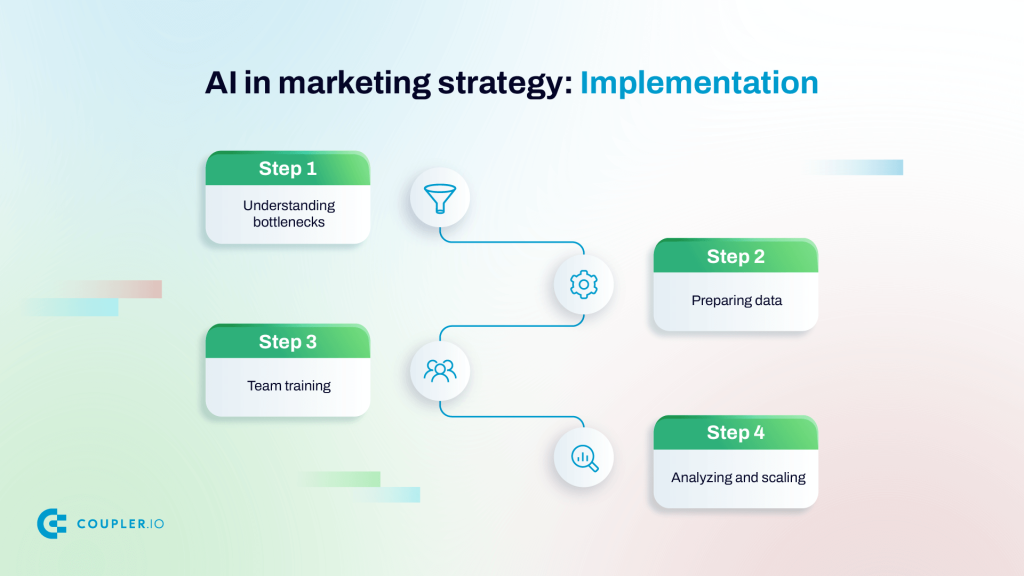
Step 1. Understand your bottlenecks
Start by identifying your team’s inefficient workflows – especially those that impact your ability to plan and make quick decisions. Pay attention to processes where performance predictions require guesswork, analysis takes several hours, or content optimization is done manually.
Document these bottlenecks with specific time estimates (audience analysis = 6 hours weekly) and their impact on decision speed. This will help you prioritize which areas to focus on first. As Lars Nyman, Fractional CMO at Nyman Media puts it:
The best companies aren’t blindly “using AI”; they’re mapping their bottlenecks first. I tell clients: don’t automate chaos. It’s tempting to launch into execution immediately, but step one is always documenting where time, money, and sanity are bleeding out, and only then looking into toolkits and integrations.
Step 2. Prepare your marketing data
Data preparation is the first pillar of becoming data-driven and building an effective AI-driven marketing strategy. With dozens of sources to manage, marketers are turning to automation to keep data organized and accurate. A third of our respondents already use AI for this purpose, which aligns with our AI in data analytics research showing that 34% use AI to automate data collection and refinement. This includes data cleaning tasks like removing formatting inconsistencies or duplicate records in CRMs, email lists, and customer profiles.
Meanwhile, Coupler.io allows you to gather data from business sources like CRMs (HubSpot, Pipedrive), social media platforms (Facebook, TikTok, LinkedIn), email marketing platforms (Mailchimp, Brevo), and more. You can create clear, unified dashboards with the help of pre-built templates like these:
Step 3. Train your team for AI success
Make sure everyone on the team understands how the AI marketing tools work and what their limitations are. In our 2023 research, poor communication was a major blocker for teams trying to build data-driven strategies. That’s why training should go beyond technical instructions – it’s more about creating a set of rules and common processes. For instance:
- Share practical examples of how AI can support marketing tasks like campaign optimization and competitor research. This will help newcomers get started quickly.
- Develop an internal playbook for engaging with AI technology. Document best practices, data sharing limitations, and instances where human judgment should be prioritized.
- Encourage open discussion about AI so the team can identify new AI marketing use cases (e.g., chatbot for FAQs), refine prompting techniques, and make workflow improvements over time.
Step 4. Start with focused testing
Rather than implementing AI in every project, the most effective teams start with a handful of low-risk, targeted use cases. For example, you could experiment with AI for PPC forecasting before expanding to broader campaign strategy, or test AI-powered audience segmentation in GA4 before applying it to your overall customer targeting approach.
Define clear success metrics upfront, like ‘15% increase in lead quality scores’ or ‘20% improvement in campaign ROI prediction.’ Timeboxing the experiments (30-60 days, a quarter, etc.) will help you evaluate results more efficiently.
This kind of targeted testing can deliver results quickly. Chris Simental, Co-Founder & Tech Strategist at RIPE, shared an example:
We recently used AI to optimize ad creative for a nonprofit client. Instead of running long, costly A/B tests, we fed past campaign performance data into an AI model, which suggested creative variations with the highest predicted engagement. The result: a 32% lift in CTR in the first two weeks, without increasing spend.
Step 5. Scale what works
Analyze what did and didn’t work about your AI experiments, then apply those learnings to other projects and initiatives. For instance, if AI-driven PPC forecasting helped optimize budget allocation, extend the approach to campaign planning for other contexts (e.g., lead generation).
Common implementation challenges to keep in mind
Here are a few roadblocks teams often face when implementing an AI-driven marketing strategy:
Unrealistic expectations. Even with clean data or perfectly-worded prompts, AI may not deliver high-quality outputs from the get-go. It can also hallucinate and provide misleading information. Consider that it may take some trial and error before some tools or features provide consistent results.
Internal pushback. New, AI-driven workflows can feel intimidating, especially when the benefits aren’t clear. That’s why it’s important to focus on small but impactful use cases from day one. Sharing early wins (20% increase in MQLs through AI-optimized content) can also help the team see value in revamped processes.
Advice that doesn’t make business sense. AI might suggest strategies that work in theory but don’t take into account your marketing budget, brand voice, or customer preferences. Provide AI models with business context when possible, but always balance their recommendations with your own judgment and expertise.
Metrics to measure the impact of AI on strategic performance
If you’re investing in AI for marketing strategy, you need a way to prove it’s delivering value. Alongside your core KPIs – conversion rate, acquisition costs, customer satisfaction, revenue, etc. – it’s worth tracking metrics that highlight AI’s contribution to better outcomes. For instance:
- Productivity gains. Measure the reduction in time spent on tasks like content optimization, market research, and manual customer data analysis. Example: Summarizing reports now takes minutes instead of hours every week.
- Faster time-to-decision. Track how quickly your team can implement or adjust new creatives, campaign goals, budgets, product messaging, audience targeting, etc. Example: Shifting ad budget within a day rather than waiting for your monthly PPC reports to come through.
- Revenue attribution. Monitor any improvements in attribution accuracy since you started using AI to optimize the customer journey. Example: AI shows that 40% of conversions came from a mix of paid search + webinar touchpoints, which manual tracking had previously credited only to email.
- Forecasting accuracy. Compare AI predictions against results from current and past forecasts. Are they more reliable overall and how has it impacted your strategy? Example: Churn risk forecasts are now 25% more accurate, helping you redirect budget toward retention campaigns.
- Cost efficiency. Has AI implementation helped reduce acquisition costs or reallocate budgets more effectively? Example: AI consistently flags underperforming ad sets on Facebook and LinkedIn, cutting wasted spend by about 30%.
Future outlook: the evolution continues
Our research shows that most teams are still in the early stages of strategic AI adoption, but that’s changing fast.
The future of AI-driven marketing strategy is less about task automation and more about having an always-on strategic consultant. Here’s what we can expect more of in the coming months and years:
- Improved AI-powered forecasting that predicts market shifts and recommends strategic pivots.
- Hyper-personalized customer journeys, where AI automatically optimizes certain touchpoints (email scheduling, onboarding flows, etc.) based on individual customer needs.
- Self-optimizing campaigns that adjust targeting, budgets, and messaging in real-time, helping you stay ahead of the competition.
Can you rely on AI to shape and execute strategies from scratch? Not yet, and that’s probably a good thing. Human insights are still crucial for developing strategies that align with your team resources, target audience, and industry niche. Abhishek Shah, Founder at Testlify, had this parting advice:
Don’t let AI run the show; let it handle the heavy lifting so your team can focus on creativity and judgment.
AI is great at finding patterns and scaling execution, but it’s your unique insights, brand voice, and ability to connect emotionally with your audience that make the strategy work long-term. Use AI to amplify, not replace, your team’s expertise.
Will AI take my job? This is one of the most acute questions different experts raise. The answer is no, if you won’t let it, of course. However, instead, it’s better to make AI your strategic marketing partner. Coupler.io offers built-in dashboard insights and AI tool integrations to simplify analysis and decision-making. Unify your data in minutes and get actionable recommendations in a few clicks – all with a free 7 day trial, no credit card required.

